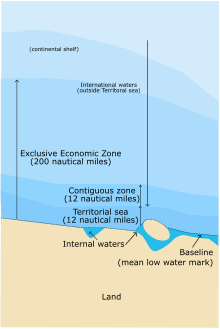
Back حدود بحرية Arabic Frontera marítima Catalan Marlimo Esperanto Límite marítimo Spanish مرز آبی Persian Frontière maritime French ព្រំដែនសមុទ្រ Cambodian Jūras robeža Latvian/Lettish Sempadan maritim Malay सामुद्रिक सीमाना Nepali

A maritime boundary is a conceptual division of Earth's water surface areas using physiographical or geopolitical criteria. As such, it usually bounds areas of exclusive national rights over mineral and biological resources,[1] encompassing maritime features, limits and zones.[2] Generally, a maritime boundary is delineated at a particular distance from a jurisdiction's coastline. Although in some countries the term maritime boundary represents borders of a maritime nation[3] that are recognized by the United Nations Convention on the Law of the Sea, maritime borders usually serve to identify the edge of international waters.
Maritime boundaries exist in the context of territorial waters, contiguous zones, and exclusive economic zones; however, the terminology does not encompass lake or river boundaries, which are considered within the context of land boundaries.
Some maritime boundaries have remained indeterminate despite efforts to clarify them. This is explained by an array of factors, some of which involve regional problems.[4]
The delineation or delimitation of maritime boundaries has strategic, economic and environmental implications (see maritime delimitation).[5]
- ^ VLIZ Maritime Boundaries Geodatabase, General info; retrieved 19 November 2010
- ^ Geoscience Australia, Maritime definitions; retrieved 16 January 2023
- ^ United States Department of State, Maritime boundaries ; retrieved 19 November 2010.
- ^ Valencia, Mark J. (2001). Maritime Regime Building: Lessons Learned and Their Relevance for Northeast Asia, pp. 149-166., p. 149, at Google Books
- ^ Geoscience Australia, Law of the Sea and Maritime Jurisdiction Project.